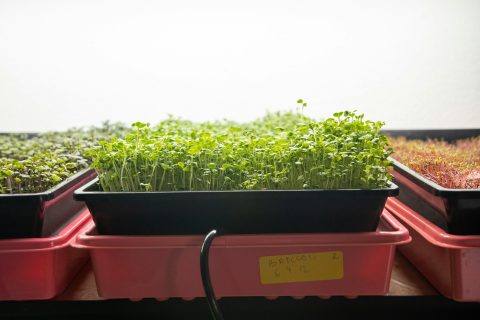
Bugs in your vegetable garden can be a real pain. They chew leaves, damage crops, and make gardening harder than it has to be. You might feel frustrated watching pests ruin the vegetables you worked so hard to grow.
But don’t worry, there are natural ways to fight back! Learning how to keep bugs out of vegetable gardens can save your plants without using harsh chemicals.
This post will provide practical tips on using beneficial insects and making homemade sprays.
Let’s protect your precious veggies together! Keep reading for easy solutions.
Jump to Section [Hide]
1. Build a Strong Foundation
Start with healthy soil, it’s the base of a thriving garden. To make your work easier, choose plants that naturally fight off pests.
Encourage Healthy Soil
Add compost to enrich the soil with nutrients. Use organic fertilizer or mulch, such as wood mulch, to improve the soil’s structure and retain moisture.
Rotate crops each year to break pest cycles and boost soil health. Plant nitrogen-fixing plants, like legumes, add natural nutrients to the ground. Avoid tilling too much, as it can harm helpful microorganisms in the soil.
Choose Pest-Resistant Plants
Pick plants that bugs dislike. To reduce insect pests, grow pest-resistant options like cabbage and broccoli. Tomatoes, carrots, and onions also naturally fight off many harmful bugs.
Add herbs such as basil or dill near vegetables for extra protection. Garlic keeps away aphids, while mint repels flea beetles and moths. These choices make organic gardening easier by cutting the need for bug sprays or pesticides!
2. Keep Your Garden Tidy
A messy garden invites pests. Remove dead plants and weeds to keep bugs away.
Maintain Garden Cleanliness
Clear out decaying plant matter often. Rotting leaves attract pests like fungus gnats and harmful microorganisms, which can quickly harm your crops.
Fallen fruits and vegetables should be disposed of immediately. Poor sanitation can make them food sources for mice, flies, or even collapsed colonies. Keep tools clean to avoid spreading parasites or diseases to plants.
Control Weeds Effectively
Pull weeds often to prevent them from taking over. Use tools like a hoe or hand trowel to remove weeds at the root.
Apply mulch around your crops. This blocks sunlight and keeps weeds from growing. Crop rotation also helps limit weed growth by breaking their life cycle.
3. Use Natural Gardening Techniques
Natural methods can keep pests away and protect your plants. Use smart planting and welcome helpful bugs to your garden!
Practice Companion Planting
Plant marigolds near tomatoes to repel tomato hornworms. Use nasturtiums with cabbage plants to keep cabbage moths away. Garlic, onions, and basil deter pests like carrot flies and whiteflies.
Group certain plants together for better pest control. For example, plant yarrows or chives near crops to attract predatory insects like ladybugs and hoverflies. These helpers eat pests that harm your garden.
Attract Beneficial Insects
Add plants that attract natural predators like ladybugs and parasitic wasps. These insects eat harmful bugs such as aphids, whiteflies, and cutworms. Eastern bluebirds can also help; they love caterpillars and Japanese beetles.
Create a pollinator garden with nectar-rich flowers to attract honeybees and other pollinators to your yard. Insect hotels improve plant health while scaring off pests. They also invite helpful bugs to stay longer.
4. Employ Natural Pest Deterrents
Keep bugs away using safe methods. Try natural solutions that are gentle on your plants but tough on pests!
Use Diatomaceous Earth
Sprinkle food-grade diatomaceous earth on your vegetable garden’s soil. It kills crawling bugs like flea beetles by cutting their bodies. Apply it around plants, especially near tomato plants and squash vines, to stop pests early.
Till the soil is used to break pest life cycles, this step helps control bugs’ breeding grounds. Diatomaceous earth is a natural pest control option that is safe for organic gardening and sustainable farming methods.
Spray with Neem Oil or Garlic Spray
Neem oil is effective for organic pest control. It effectively tackles squash vine borers, white flies, and thrips. Mix it with water and spray it on leaves in the early morning. This keeps harmful insects away without hurting beneficial ones.
Garlic spray also acts as a strong repellent! Blend garlic cloves with water to create your mix. Spray this on plants to protect them from flying bugs like mosquitoes or potato beetles.
Use either option weekly for the best results!
5. Physical Barriers and Strategic Placement
Protecting your plants starts with simple barriers. To minimize garden pests efficiently, use tools like row covers or traps.
Install Row Covers or Mesh Netting
Cover your plants with row covers or mesh netting to block garden pests. These barriers keep bugs, birds, and mice away from your vegetables. Use a fine mesh for small insects like aphids or cabbage worms.
Build tall fencing 5 to 6 feet high to protect against deer in areas near fruit trees or cornfields. Secure the edges of the netting firmly so pests can’t sneak under. This method also supports sustainable gardening by avoiding harmful insecticides.
Use Sticky Traps
Place yellow sticky traps around your vegetable garden. These traps lure and catch harmful bugs, like aphids and whiteflies. Position them near plants like tomatoes or cauliflower to protect against pests.
Check the traps often to see what insects are caught. Replace them when full for continued pest control. Sticky traps are chemical-free, making them safe for organically grown foods and pollination helpers like bees.
Space Plants Correctly
Give each plant enough room to grow. Crowded plants attract pests and block airflow, creating damp spots where bugs and diseases thrive.
Leave space for sunlight to reach every leaf. Proper spacing helps the soil dry faster after watering, stopping pests from nesting in wet dirt. Rotate crops like legumes yearly to break pest cycles and boost soil health with nitrogen.
6. Strategic Watering and Maintenance
Watering at the right time can keep pests away and prevent diseases. Proper care helps your plants grow strong, making them less attractive to bugs.
Water Early in the Morning
Start watering your garden early. Morning watering helps plants stay strong by supporting photosynthesis. It also reduces the risk of fungus, which loves damp conditions at night.
If pests damage crops like strawberries, those fruits may have extra antioxidants and nutrients! Keep bugs under control while enjoying this surprising benefit. Water wisely to support healthy soil and pest management in agriculture.
Avoid Overwatering
Too much water invites root rot and fungal diseases. Bugs also love the damp soil that overwatering creates. Water your garden early in the morning to let it dry throughout the day.
Stick to a schedule but adjust for rain or plant needs. Blackberries, apples, and citrus trees don’t need constant soaking. Also, keep an eye on how moist the soil feels. Plants should not sit in puddles.
Healthy roots mean healthy plants, keeping pests at bay!
7. Monitor and Act Proactively
Check your plants often. It’s the best way to catch problems early. Look for chewed leaves, small pests, or signs of trouble, and act fast!
Inspect Plants Daily
Look at your plants every day or two. Spot pests early to stop damage fast. Check leaves, stems, and soil for insects like aphids or caterpillars. Also, notice any holes, spots, or yellowing that could mean trouble.
If you find bugs like praying mantis eggs or ladybugs’ larvae, leave them alone, they’re helpers! Grow some extra plants as “host” areas for minor pests. This can keep bad bugs away from your main crops while keeping balance in the garden’s ecosystem.
Remove Pests Manually
Pick pests off your plants by hand. It’s simple but works well for small gardens. Wear gloves if needed. To kill bugs like caterpillars or beetles quickly, drop them into a bucket of soapy water.
Check under leaves and around stems daily. Manually removing pests shows you care about healthy, organic food, not poor gardening skills. This method also keeps chemicals out of your garden!
Seasonal Tips and Long-Term Planning
Plan your garden with the seasons in mind. Rotate crops yearly to outsmart pests and boost soil health.
Adjust Pest Control with Seasons
Pests change with the seasons, so your approach should, too. In warmer months, you might see more aphids and caterpillars. To handle them, use insecticidal soap or Bacillus thuringiensis.
Watch for mice or slugs as it cools, set traps, or use orange peels to keep them away.
Rotate crops yearly to break pest cycles. For example, plant legumes like beans or peas one year and leafy greens the next. This adds nitrogen to the soil and keeps pests guessing! Integrate biocontrols like nematodes during specific growing periods for better results.
Rotate Companion Planting Layouts
Change your companion plants every year. Rotating crops like tomatoes, beans, and cucumbers keeps pests guessing. For example, plant nasturtiums near brassicas one year to prevent cabbage moths, then switch their spots the following season.
This confuses harmful bugs and protects your vegetables.
Moving plants also helps the soil stay healthy. It prevents pests from building nests in familiar spots and slows the spread of disease. To achieve even better results, rotate layouts with other pest-resistant plants.
The Bottom Line
Natural methods can help keep bugs out of your garden. Healthy soil and pest-resistant plants can make a big difference. Tidy up, control weeds, and use clever planting tricks like companion planting.
Natural sprays or diatomaceous earth help keep pests away, too. Try row covers and place plants wisely for extra protection. Daily checks let you catch problems fast before they spread.
Which tip will you try first? Do not stop learning, share your ideas or questions with others who love gardening, too! With these steps, your veggies can thrive bug-free all season long!








